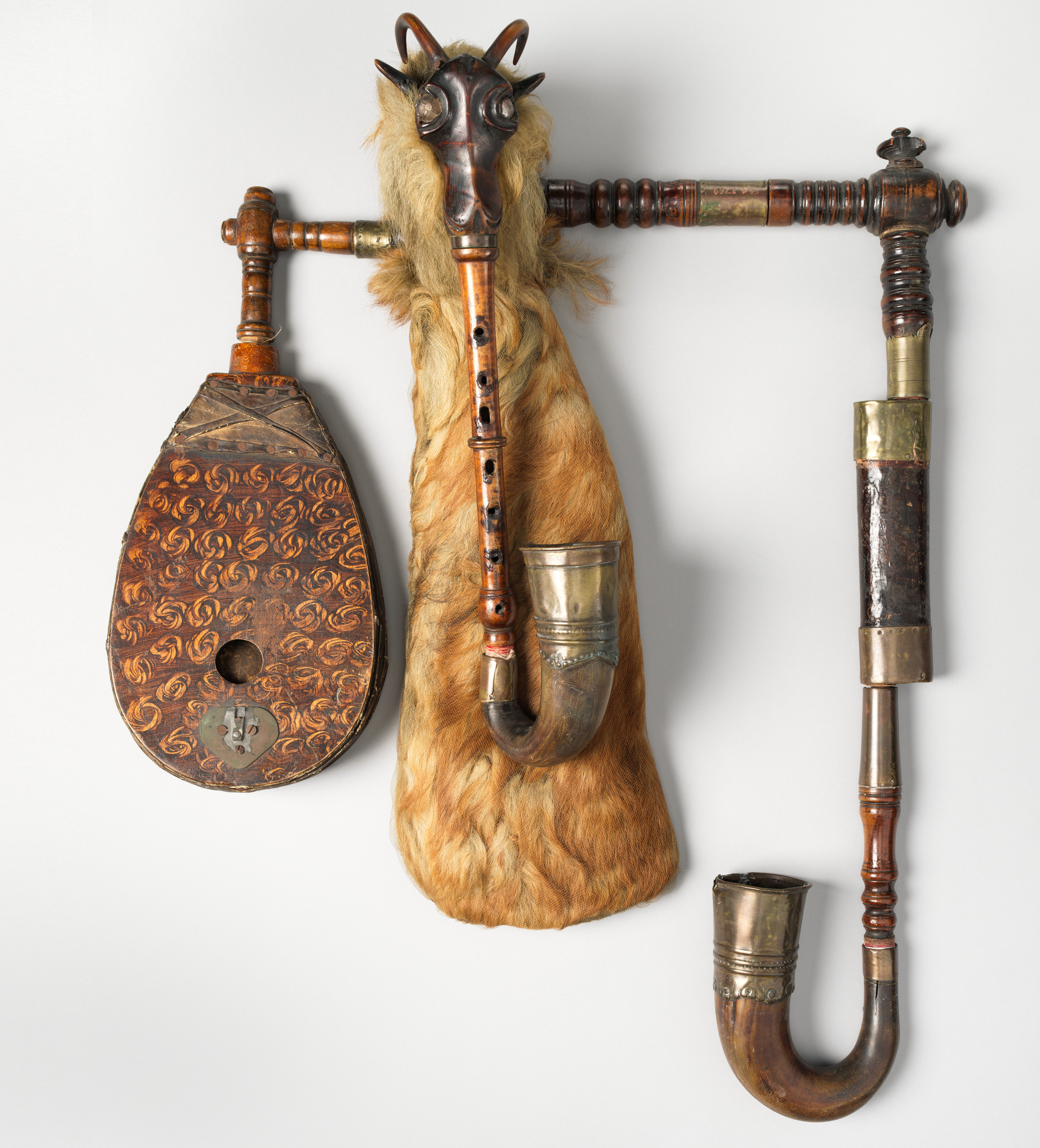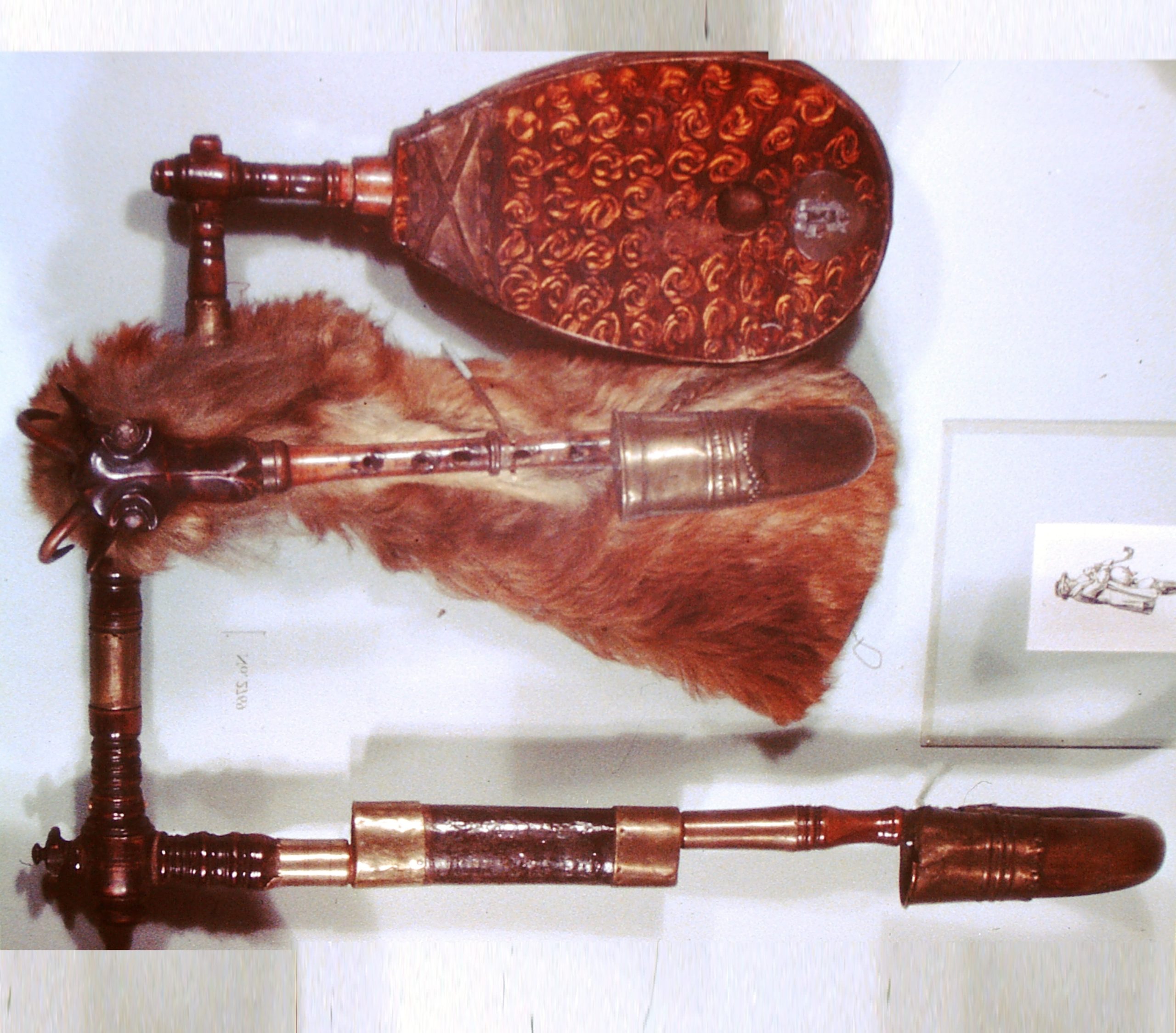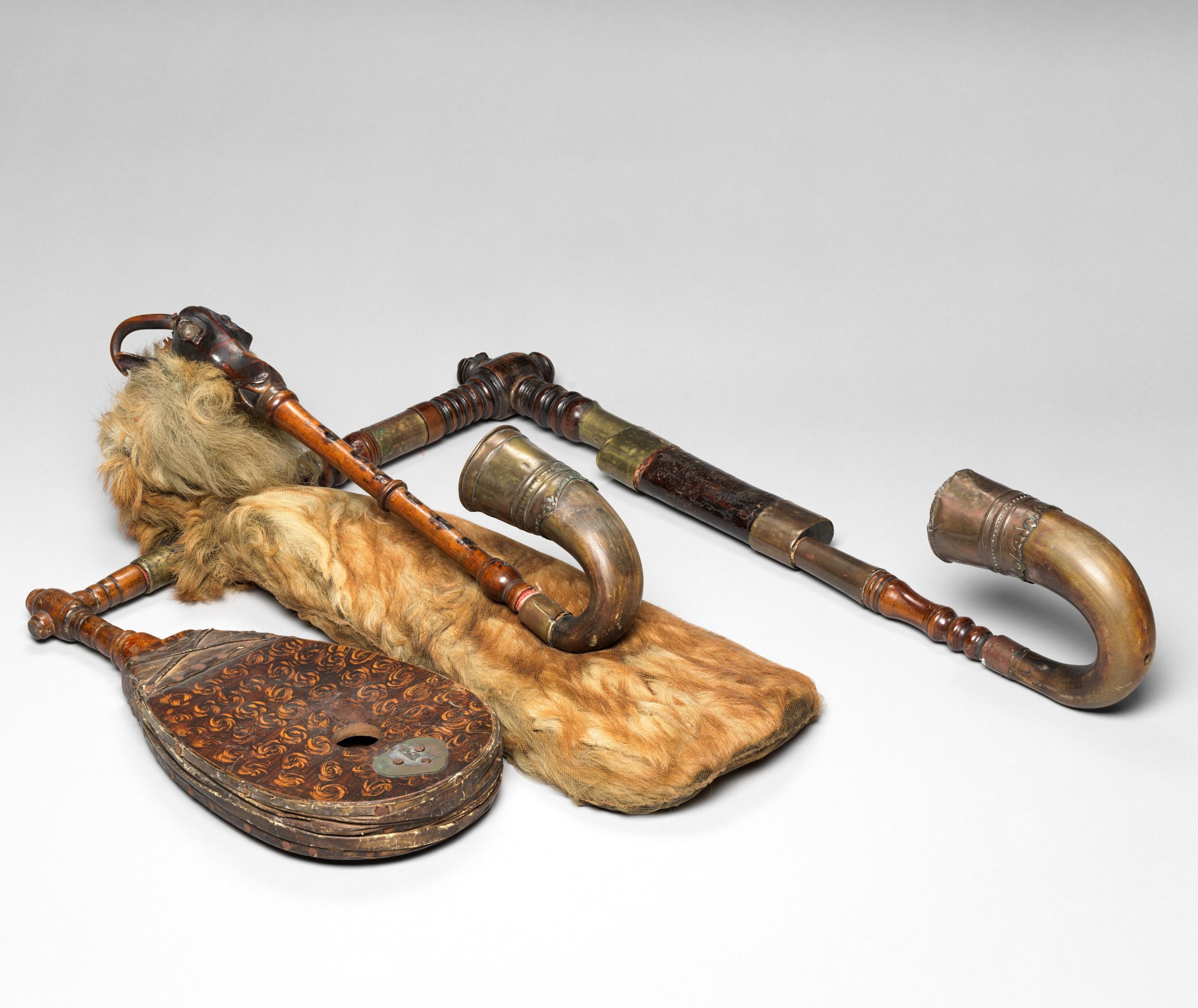Bock
Woodwinds
Europe
Between 1001 and 1900 AD
Video
The bock is a traditional musical instrument, primarily classified as a wind instrument. More specifically, it falls under the category of single-reed woodwind instruments. This classification arises from its method of sound production, which involves a single reed vibrating against a mouthpiece. The player blows air into the instrument, causing the reed to vibrate and produce sound. The bock is characterized by its relatively simple construction and its close association with folk music traditions. While its specific design and materials can vary across different regions and cultures, the fundamental principle of a single vibrating reed remains consistent. This basic mechanism makes it related to other single-reed instruments like the clarinet and saxophone, although the bock possesses its own distinct timbral qualities and playing techniques. It is essential to understand the bock’s classification as a wind instrument to appreciate its role in musical ensembles and its unique sound production method.
History of the Bock
It is generally believed to have originated in Eastern Europe, specifically among Slavic and Baltic communities. While precise dates remain elusive, its roots are thought to extend back several centuries, possibly to the 18th or 19th century. The bock’s connection to folk music traditions indicates that it likely emerged within rural communities, where it was used for both social gatherings and ritualistic purposes. The instrument’s history is closely linked to the cultural practices of the regions where it was prevalent. Its use in folk music ensembles suggests its importance in community life and celebrations. Further research into historical records and ethnomusicological studies may reveal more specific details about the bock’s origins and its spread across different regions. It’s crucial to acknowledge the limitations in tracing its precise history and appreciate its cultural significance within its specific context.
Historical Context and Usage
The bock’s historical context is closely tied to the folk music traditions of Eastern Europe. It was primarily used in rural communities, where music played a vital role in social life. The instrument’s simple construction made it accessible to many people, contributing to its popularity in folk ensembles. It was often played at gatherings, festivals, and celebrations, providing musical accompaniment for dances and songs. The bock’s sound, often described as rustic and mellow, suited the character of folk music. Its association with rural life and cultural traditions contributed to its significance within these communities. The instrument may have also been used in ritualistic contexts, although information on this aspect is often limited. Further research into ethnomusicological studies and archival materials may shed more light on the diverse ways in which the bock was used throughout its history. It is vital to recognize the bock’s historical importance as a cultural artifact and its contribution to the rich tapestry of folk music traditions.
Construction and Design
Materials Used
The construction of a bock typically involves a combination of wood, reed, and occasionally metal. The body of the instrument, often referred to as the “pipe,” is usually crafted from wood. The type of wood used can vary depending on the region and the availability of materials, but hardwoods like maple, cherry, or boxwood are common choices. These woods are chosen for their durability and tonal properties. The reed, which is the vibrating element, is typically made from a specific type of cane. This cane is carefully selected and shaped to produce the desired sound. The reed is attached to the mouthpiece, which can also be made of wood or occasionally metal. Metal may be used for certain parts of the instrument, such as keys or bands, depending on the specific design. The choice of materials influences the instrument’s tonal qualities, durability, and overall appearance. The craft of bock making is often passed down through generations, with skilled artisans employing traditional techniques and knowledge.
Design Elements and Functionality
The design of a bock, while relatively simple, incorporates several key elements that contribute to its functionality. The pipe, or body of the instrument, is typically cylindrical or slightly conical in shape. The bore, which is the internal diameter of the pipe, plays a crucial role in determining the instrument’s tone and range. The pipe usually features tone holes, which are holes drilled along its length. These tone holes are covered or uncovered by the player’s fingers to change the pitch of the notes. The mouthpiece, as mentioned earlier, is where the reed is attached. It is designed to direct the air into the instrument and facilitate the vibration of the reed. The bell, located at the end of the pipe, can also influence the instrument’s sound. The design of the bock often reflects regional variations and the specific musical traditions it is associated with. While the basic principles of construction remain similar, subtle differences in design can result in variations in sound and playing characteristics.
Types of Bocks
While the fundamental principle of the bock remains consistent, different types of bocks exist, varying in size, design, and playing characteristics. These variations often reflect regional differences and the specific musical traditions they are associated with.
One way to categorize bocks is by their regional variations. Different regions or communities may have their own unique designs and playing styles. These regional variations can manifest in the materials used, the shape and size of the instrument, and the number and placement of tone holes. For instance, bocks from certain regions may be smaller and higher pitched, while others may be larger and produce a deeper sound. These variations reflect the diverse musical traditions and cultural influences present in different areas. Studying these regional variations can provide valuable insights into the history and development of the bock as a folk instrument. Bocks can also be categorized based on their size and range. Some bocks are designed to produce a higher range of notes, while others are better suited for lower notes. This variation in range is often related to the size and bore of the instrument. Larger bocks generally have a deeper range, while smaller bocks tend to have a higher range. The size and range of a bock are often chosen to suit the specific musical requirements of the ensemble or the musical style being played. Understanding these variations in size and range can help musicians select the appropriate instrument for their musical needs.
Another way to categorize bocks is based on whether they have keys. Some bocks are keyless, meaning that the player directly covers the tone holes with their fingers to change the pitch. Other bocks may have keys, which are mechanical levers that extend the player’s reach and allow them to play notes that would otherwise be difficult or impossible to reach. Keyed bocks offer a wider range and greater flexibility in playing, but they also tend to be more complex to construct and maintain. The choice between a keyed and keyless bock often depends on the player’s preference, the musical style being played, and the level of technical proficiency.
Characteristics of the Bock
The bock possesses several distinctive characteristics that contribute to its unique sound and playing style. These characteristics include its tonal qualities, playing techniques, and its role in ensembles.
The bock’s tonal qualities are often described as rustic, mellow, and warm. Its sound is distinct from other woodwind instruments like the clarinet or saxophone, often possessing a more earthy or folksy character. The sound is produced by the vibration of the single reed against the mouthpiece. The wood material of the instrument’s body and the specific design of the bore also influence its tonal qualities. The bock’s sound lends itself well to folk music, where it is often used to create a sense of intimacy and connection to cultural traditions. Playing the bock requires a combination of breath control, embouchure, and finger technique. The player needs to develop a steady air stream to produce a consistent sound. The embouchure, which is the way the player positions their mouth on the mouthpiece, is crucial for controlling the reed and producing a good tone. The player uses their fingers to cover and uncover the tone holes, changing the pitch of the notes. Developing proficiency on the bock requires practice and dedication. Skilled players can achieve a wide range of expressive effects, including vibrato and ornamentation.
The bock typically plays a melodic role in ensembles. It is often used to play the main melody line in folk tunes. In some ensembles, it may also play harmonies or countermelodies. The bock’s sound blends well with other folk instruments, such as accordions, fiddles, and drums. It contributes to the overall texture and character of the music. The bock’s role in ensembles varies depending on the specific musical traditions and the arrangement of the pieces. In some cases, it may be the lead instrument, while in others, it may play a supporting role.
Playing Techniques and Sound Modifications
Playing the bock involves a combination of bowing and fingering techniques. The bow, typically held in the right hand, is drawn across the strings to produce sound. Different bowing styles can create a variety of tonal colors, from smooth and legato to short and staccato. The left hand is responsible for pressing down the strings on the fingerboard to change their pitch. Various fingering patterns and techniques, such as slides, vibrato, and harmonics, can be employed to add nuance and expression to the music. The bock’s relatively short neck and closely spaced strings allow for intricate fingerwork and complex melodies. Some players utilize a technique called “double stopping,” where two strings are played simultaneously to create a harmony.
The angle of the bow, the pressure applied to the strings, and the position of the bow on the string (closer to the bridge or the fingerboard) all contribute to variations in tone and volume. Advanced players often experiment with different bowing techniques to achieve a wide range of sonic textures. Beyond traditional playing methods, some musicians explore unconventional techniques, such as plucking the strings, tapping on the body of the instrument, or using effects pedals to modify the sound. These explorations can expand the bock’s sonic possibilities and push the boundaries of its traditional sound.
Applications in Music
The bock finds its primary application in folk music traditions. It is often used to accompany songs, provide instrumental interludes, or play solo pieces. The instrument’s versatility allows it to adapt to various musical contexts, from lively dance tunes to slow, melancholic ballads. In some cultures, the bock is an integral part of traditional ceremonies and celebrations, its music adding a unique cultural flavor to the event. While primarily associated with folk music, the bock has also found its way into other genres. Some contemporary musicians have incorporated the bock into their compositions, blending its distinctive sound with elements of classical, jazz, or world music. This cross-genre exploration has helped to broaden the instrument’s appeal and introduce it to new audiences. The bock’s melodic capabilities and its ability to create both rhythmic and harmonic textures make it a valuable instrument in a variety of musical settings. Its unique timbre distinguishes it from other stringed instruments, making it a sought-after sound for composers and musicians looking for something different.
Most Influential Players
Identifying the “most influential” players of the bock can be challenging, as its popularity is often localized and its traditions are primarily oral. However, within specific communities and regions, certain individuals have achieved recognition for their mastery of the instrument and their contributions to its musical heritage. These players often serve as mentors and teachers, passing down their knowledge and skills to younger generations. They may also be renowned for their innovative playing styles, their compositions, or their efforts to preserve and promote the bock’s musical traditions. Some influential players have made recordings of their music, making their artistry accessible to a wider audience. These recordings can serve as valuable resources for students and researchers interested in learning more about the bock and its playing styles. It is important to acknowledge that the concept of “influence” can be subjective and may vary depending on cultural context. In many cases, the most influential players are those who have had a profound impact on their local communities, even if they are not widely known outside of those circles. Their dedication to the bock and their role in transmitting its musical heritage are invaluable.
Maintenance and Care
The bock, like any stringed instrument, requires regular maintenance and care to ensure its longevity and optimal performance. The strings, being made of gut or synthetic material, are subject to wear and tear and need to be replaced periodically. The frequency of string changes depends on the amount of playing and the type of strings used. The instrument’s body and neck should be cleaned regularly with a soft cloth to remove dust and dirt. Avoid using harsh chemicals or abrasive cleaners, as these can damage the finish. The bridge and tailpiece should also be checked for any signs of wear or damage. If the instrument is not being played, it should be stored in a case or a protective bag to prevent it from being exposed to extreme temperatures or humidity. These environmental factors can cause the wood to warp or crack. Regular inspections by a qualified luthier are recommended to address any potential issues, such as loose braces, cracks in the wood, or problems with the tuning pegs. Proper maintenance and care will help to preserve the bock’s sound quality and ensure that it remains a playable instrument for many years.
Cultural Significance
The bock often holds deep cultural significance within the communities where it is played. It is more than just a musical instrument; it is a symbol of tradition, heritage, and identity. In some cultures, the bock is associated with specific rituals, ceremonies, or festivals, its music playing an essential role in these events. The instrument’s sound may evoke a sense of connection to the past, reminding listeners of their ancestors and their cultural heritage. The bock’s music can also serve as a form of social commentary, expressing the joys, sorrows, and aspirations of the community. The songs played on the bock may tell stories, recount historical events, or convey moral lessons. The instrument’s role in preserving and transmitting cultural traditions is invaluable.
It helps to connect generations and to maintain a sense of continuity with the past. The bock’s cultural significance extends beyond its musical function. It can also be a source of pride for the community, representing their unique artistic and cultural contributions. The instrument’s presence in cultural events and performances helps to strengthen community bonds and to promote a sense of collective identity. The bock, therefore, is not just a musical instrument, but a vital cultural artifact that embodies the history, traditions, and values of the communities where it is played.
FAQ
What is the Bock musical instrument and its origin?
The Bock is a traditional bagpipe from Central and Eastern Europe, especially used in the Czech Republic and Slovakia. It features a large, often elaborately carved wooden stock. The instrument has been played for centuries in folk music traditions.
What materials are used to construct the Bock?
The Bock is typically made from wood for the chanter and drones, with a leather or synthetic bag. The reeds are crafted from cane or plastic, and the stock is often ornately carved. These materials contribute to its warm, resonant sound.
How is the Bock played and what type of music does it produce?
The Bock is played by blowing air into the bag and squeezing it to maintain airflow through the chanter and drones. It produces a continuous, droning sound ideal for folk music, especially dance tunes and traditional European melodies.
 Links
Links
References
Other Instrument
Categories




















